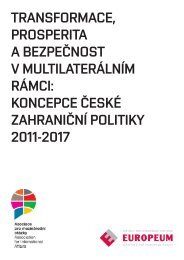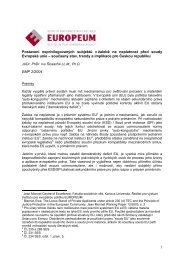eu constitutionalisation - EUROPEUM Institute for European Policy
eu constitutionalisation - EUROPEUM Institute for European Policy
eu constitutionalisation - EUROPEUM Institute for European Policy
Create successful ePaper yourself
Turn your PDF publications into a flip-book with our unique Google optimized e-Paper software.
Chapter 8: EU Development <strong>Policy</strong> in the Constitutional Treaty: a Step <strong>for</strong>ward?The realisation of the role of the EFM, which is so ambitiously constructedin the Treaty, will depend in practice on personal interests and diplomaticskills of the person appointed to that position. As s/he will be anchoredin two institutional bodies and has to balance between them, it couldlead to tensions between two roles, and in this tug-of-war between theCommission and the Council, one of them could become the centre ofgravity. If the EFM will be pulled towards the Council, it could endangerhis/her credibility within the Commission and as a result, weaken theCommunity’s external activities. To sum up, the role of the EFM willrequire a lot of sensitivity in her/his approaches to the Council and tothe Commission and maybe even some new innovative solutions will beinvented²³.Nevertheless, the EU’s external action will be strengthened through thepost of the <strong>European</strong> Foreign Minister. The implications of that fact <strong>for</strong>development cooperation may be doubled depending on the personalattitudes and interests of the EFM. The constitutional treaty provides <strong>for</strong>the EFM to coordinate the Community’s external actions; however, itshandling towards other fellow Commissioners is not clear. It could leadto a situation where the Commissioners responsible <strong>for</strong> other aspectsof external actions, such as development cooperation, take a juniorposition to the EFM. If the EFM is interested in development cooperationas a tool of strategic, long term approach <strong>for</strong> combating poverty,it may gain much more importance than in the current structure. Ifnot, it will mean a further subordination of development cooperationto <strong>for</strong>eign policy.Structure of <strong>European</strong> CommissionIn the context of the position of development cooperation in the future,the structure of the <strong>European</strong> Commission is also relevant. In an enlargedUnion the principle of collegiality, equality of Commission’s members, andthe representation of every Member State in the Commission may badlyaffect the effectiveness of the Commission’s work. How to ensure the properfunctioning of the Commission in the <strong>European</strong> Union of 25 or morewas one of the crucial and very sensitive questions during the <strong>European</strong>Convention and then also during the IGC. Finally, the representatives of23) Ibid.Chapter 8: EU Development <strong>Policy</strong> in the Constitutional Treaty: a Step <strong>for</strong>ward?the member states did not accept the proposal from the Draft Treaty, northe alternative solution proposed by the <strong>European</strong> Commission²⁴.The particular controversies referred to the Commission’s compositionand its internal decision-making process. Finally, the member statesagreed in Article I-25 that the first Commission appointed after the constitutionaltreaty will come into <strong>for</strong>ce, and shall consist of one nationalof each country (including the President and the EFM). After the termof office ends, the next Commission shall consist of a number of Members,including its President and the Union Minister or Foreign Affairs, correspondingto two thirds of the number of member states unless the <strong>European</strong> Council, actingunanimously, decides to alter this figure. The Members of the Commission willbe selected on a rotational basis. The IGC did not insert detailed proposalsfrom the Commission, leaving the modalities on future functioning of theCommission to its future President and the Rules of Procedures laid outin Article I-27 of the treaty.In fact, the system adopted in the constitutional treaty does not mean a radicalchange and rather reflects a compromise on this sensitive issue. After theaccession of Bulgaria and Romania, the first-term Commission will probablyhave 27 members. In this composition all the Commissioners will havevoting rights, however the decision-making would become complex and itmight be necessary to <strong>for</strong>m a kind of inner cabinet, in which developmentis unlikely to be represented. Then, the operations of the RELEX grouptake on a crucial importance²⁵. Nevertheless, the Commission composedof 27 members means that development or humanitarian aid are only 1 or2 votes out of 27. This could lead to further marginalisation.In the following years the number of members of the second-termCommission appointed under the constitutional treaty will reach 18.Whether there will be a separate Commissioner <strong>for</strong> Development and whatplace development cooperation will take in the structure of the futureCommission, may depend on the Commission President’s decision, onthe personality of the future Development Commissioner and on her/hisrelationships with the EFM, especially as the treaty acknowledges theEFM’s right to coordinate Community external actions.24) See: EUROPEAN COMMISSION (2003), Communication from the Commission, A Constitution <strong>for</strong> the Union, p. 6.25) MACKIE, BASER, FREDERIKSEN and HASSE (2003), p. 15.292293








